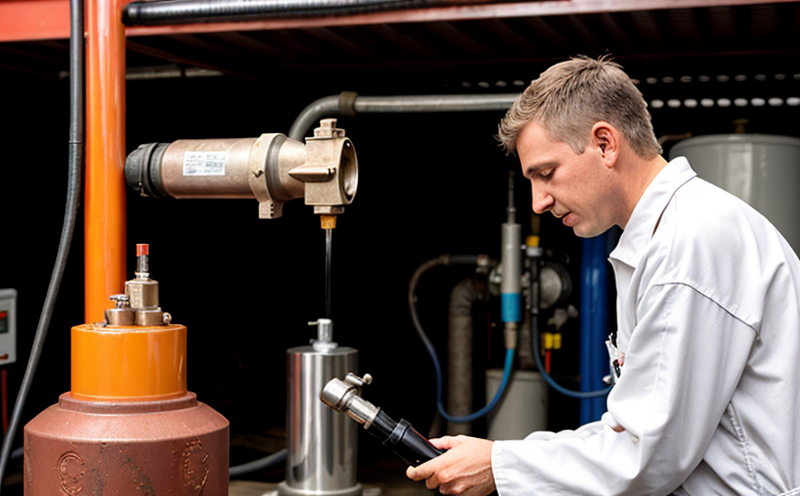SAE ARP 4418 Testing of Aviation Fuel Cleanliness and Quality
The SAE ARP 4418 is a critical standard that sets the benchmark for aviation fuel cleanliness and quality, ensuring safe and reliable aircraft operations. This testing protocol is essential in preventing engine failure due to contamination or improper fuel formulations. The standard focuses on particulate matter, water content, and other impurities which can compromise fuel performance.
SAE ARP 4418 defines the acceptable levels of contaminants that are permissible within aviation fuels. These contaminants include dust, metal shavings, and any other solid particles that could potentially damage engine components. By adhering to this standard, laboratories ensure that aircraft receive the highest quality fuel necessary for safe flight operations.
The testing process itself is intricate and involves several stages to ensure comprehensive evaluation of the fuel sample. Initial preparation includes sampling the fuel from its source, ensuring it represents a fair cross-section of the batch being tested. The sample is then analyzed using various techniques including filtration under controlled conditions, visual inspection for visible contaminants, and particle counting.
Water content in aviation fuel is another crucial aspect addressed by SAE ARP 4418 testing. Excessive water can cause ice formation within the fuel lines, leading to operational issues during flight. The standard provides specific methods to quantify water content accurately through gravimetric analysis or Karl Fischer titration.
Once all contaminants and water levels are determined, the results are compared against the limits prescribed by SAE ARP 4418. If any parameter exceeds these thresholds, corrective measures must be taken immediately to address the issue before further distribution of the fuel. This rigorous testing process not only maintains safety standards but also enhances reliability and performance of aircraft engines.
Understanding the intricacies of SAE ARP 4418 requires knowledge beyond just its basic requirements; it necessitates an understanding of how these tests impact overall aviation safety. For instance, particulate matter can range from very small microparticles to larger debris pieces depending on their origin and size distribution within the fuel. Proper interpretation of such findings helps operators make informed decisions about fuel supply chain management.
Moreover, SAE ARP 4418 plays a pivotal role in maintaining international standards for aviation fuels globally. It ensures consistency across different regions where various types of aircraft operate, thereby promoting interoperability among countries and organizations involved in the aviation industry.
Incorporating advanced technologies into this testing process enhances accuracy and efficiency significantly. Modern filtration systems allow for more precise separation between clean fuel and contaminants, while automated particle counters provide rapid yet reliable counts even at very low concentrations. These tools not only speed up the testing procedure but also reduce human error associated with manual methods.
The importance of SAE ARP 4418 cannot be overstated given its direct influence on aviation safety. By rigorously adhering to these tests, laboratories contribute immensely towards preventing accidents caused by fuel contamination or improper quality. This commitment ensures that every drop of fuel used in aircraft meets stringent international standards, ultimately safeguarding lives and property.
Benefits
Reduces risks associated with engine failure due to contamination or improper fuel formulations.
Ensures consistent quality and reliability across different regions, enhancing interoperability among countries and organizations involved in the aviation industry.
Provides peace of mind to operators knowing that they are using fuels meeting stringent international standards.
Supports compliance with relevant regulations set forth by aviation authorities worldwide.
Improves overall operational efficiency by minimizing downtime due to fuel-related issues.
Promotes safer flying environments, which is paramount in the aviation sector.
Customer Impact and Satisfaction
By ensuring that only high-quality fuels are used in aircraft engines, SAE ARP 4418 testing significantly impacts customer satisfaction. Operators can trust that their fuel meets strict safety standards, reducing the likelihood of unexpected malfunctions during flights. This trust translates into increased confidence among passengers and stakeholders alike, fostering a positive reputation for both operators and suppliers.
Additionally, adherence to SAE ARP 4418 demonstrates a commitment to excellence in quality management practices. It shows customers that rigorous controls are in place throughout the supply chain, from production through distribution. This dedication to maintaining top-tier performance levels helps build long-term relationships based on reliability and trustworthiness.
Operators who prioritize SAE ARP 4418 testing also experience enhanced brand reputation. Positive feedback from satisfied clients can lead to increased business opportunities as word-of-mouth recommendations carry significant weight in the aviation industry. Furthermore, compliance with such stringent standards may open doors for additional certifications or accreditations recognized internationally.
International Acceptance and Recognition
The global recognition of SAE ARP 4418 underscores its importance within the international community. This standard is widely adopted by aviation authorities, manufacturers, and suppliers alike because it sets a high bar for fuel quality that everyone can strive towards achieving. Its acceptance ensures uniformity in testing procedures around the world, facilitating smoother operations across borders.
International regulatory bodies like the Federal Aviation Administration (FAA) in the United States or European Union regulations often reference SAE ARP 4418 when establishing their own guidelines for aviation fuel quality. This cross-referencing emphasizes its relevance and authority within the sector. Compliance with this standard is not just beneficial but also mandatory for many organizations operating internationally.
Recognition extends beyond regulatory requirements; industry leaders incorporate adherence to SAE ARP 4418 into their corporate policies as part of their sustainability initiatives or quality assurance programs. This broader adoption further reinforces its position as a cornerstone of aviation fuel testing standards worldwide.





